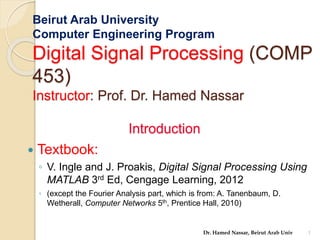
DSP_Intro_150208.pptx
- 1. Beirut Arab University Computer Engineering Program Digital Signal Processing (COMP 453) Instructor: Prof. Dr. Hamed Nassar Introduction Textbook: ◦ V. Ingle and J. Proakis, Digital Signal Processing Using MATLAB 3rd Ed, Cengage Learning, 2012 ◦ (except the Fourier Analysis part, which is from: A. Tanenbaum, D. Wetherall, Computer Networks 5th, Prentice Hall, 2010) 1 Dr. Hamed Nassar, Beirut Arab Univ
- 2. Analog, Digital, and Discrete Signals Analog Signal: Continuous time, continuous magnitude Discrete Signal: Discrete time, continuous magnitude Digital Signal: Discrete time, Discrete magnitude Terminology: ◦ Engineers: Signal ◦ Mathematicians: function Prof. H. Nassar, BAU
- 3. Analog, Digital, and Discrete Signal A discrete signal (aka discrete-time signal) is a time series, perhaps a signal sampled from a continuous-time signal. Unlike a continuous-time signal, a discrete signal is not a continuous function over the reals (i.e does not have a continuous-time argument), but is a sequence of real numbers, whose domain is a countable set, e.g. the integers. Each value in the sequence is called a sample. When the members of the countable set, representing the domain of the discrete signal obtained from sampling a continuous signal, are equally spaced in time, then there is an associated sampling rate; the sampling rate is not apparent in the data sequence, so it should be given as a separate data item. A digital signal is typically derived from a discrete signal; specifically by quantization (approximation to closest integer). Prof. H. Nassar, BAU
- 4. ADC and DAC The process of taking an analog signal as input, and give a digital version of it as output, is called Analog to Digital Conversion (ADC). The opposite process, i.e. taking a digital signal as input, and giving an analog version of it as output, is called Digital to Analog Conversion (DAC). We will show how this can be done with MATLAB. Prof. H. Nassar, BAU
- 5. ATD From the discussions on the type of signals, it should be clear how to convert an analog signal into a digital one: Sampling, quantization, Prof. H. Nassar, BAU
- 6. Digital signal processing (DSP) DSP is the mathematical manipulation of an information- carrying signal to modify or improve it in some way. It is characterized by the representation of discrete time, discrete frequency, or other discrete domain signals by a sequence of numbers or symbols and the processing of these signals. The goal of DSP is usually to measure, filter and/or compress continuous real-world analog signals, after the conversion of the signal from an analog to a digital form, by sampling and then digitizing it using an analog-to-digital converter (ADC), which turns the analog signal into a stream of discrete digital values. Often, however, the required output signal is also analog, which requires the conversion of the signal from a digital to analog form using a digital-to-analog converter (DAC). The middle stage of DSP allows such benefits as noise Prof. H. Nassar, BAU
- 7. Digital signal processing (DSP) DSP applications include audio and speech signal processing, sonar and radar signal processing, sensor array processing, spectral estimation, statistical signal processing, digital image processing, signal processing for communications, control of systems, biomedical signal processing, seismic data processing, among others. DSP algorithms have long been run on standard computers, microprocessors, and field-programmable gate arrays (FPGAs), as well as on specialized processors called digital signal processors, and on purpose-built hardware such as application-specific integrated circuit (ASICs), digital signal controllers (mostly for industrial applications such as motor control), and stream processors, among others.[2] Prof. H. Nassar, BAU
- 8. Digital signal processing (DSP) Digital signal processing can involve linear or nonlinear operations. Nonlinear signal processing is closely related to nonlinear system identification[3] and can be implemented in the time, frequency, and spatio-temporal domains. Prof. H. Nassar, BAU
- 9. Sampling The increasing use of computers has resulted in the increased use of, and need for, digital signal processing. To digitally analyze and manipulate an analog signal, it must be digitized with an analog-to-digital converter. Sampling is usually carried out in two stages, discretization and quantization. In the discretization stage, the space of signals is partitioned into equivalence classes and quantization is carried out by replacing the signal with representative signal of the corresponding equivalence class. In the quantization stage, the representative signal values are approximated by values from a finite set. The Nyquist–Shannon sampling theorem states that a signal can be exactly reconstructed from its samples if the sampling frequency is greater than twice the highest frequency of the signal, but this requires an infinite number of samples. In practice, the sampling frequency is often significantly higher than twice that required by the signal's Prof. H. Nassar, BAU
- 10. s . Prof. H. Nassar, BAU
- 11. s . Prof. H. Nassar, BAU
- 12. s . Prof. H. Nassar, BAU
- 13. s . Prof. H. Nassar, BAU
- 14. s . Prof. H. Nassar, BAU
- 15. s . Prof. H. Nassar, BAU
- 16. s . Prof. H. Nassar, BAU
- 17. s . Prof. H. Nassar, BAU
- 18. s . Prof. H. Nassar, BAU
- 19. s . Prof. H. Nassar, BAU
- 20. s . Prof. H. Nassar, BAU
- 21. s . Prof. H. Nassar, BAU
- 22. s . Prof. H. Nassar, BAU
- 23. s . Prof. H. Nassar, BAU
- 24. s . Prof. H. Nassar, BAU
- 25. s . Prof. H. Nassar, BAU
- 26. s . Prof. H. Nassar, BAU
- 27. s . Prof. H. Nassar, BAU
- 28. s . Prof. H. Nassar, BAU
- 29. s . Prof. H. Nassar, BAU
- 30. s . Prof. H. Nassar, BAU
- 31. s . Prof. H. Nassar, BAU
- 32. s . Prof. H. Nassar, BAU
- 33. s . Prof. H. Nassar, BAU
- 34. s . Prof. H. Nassar, BAU